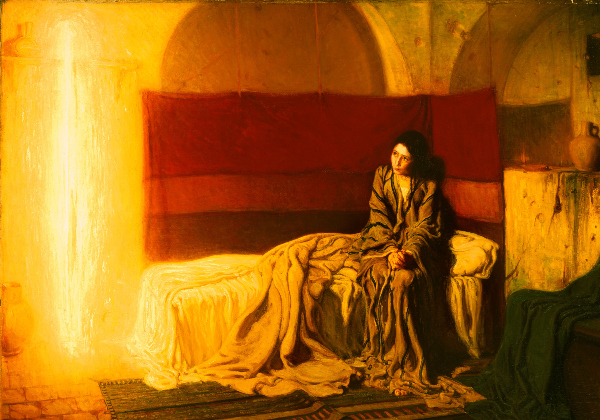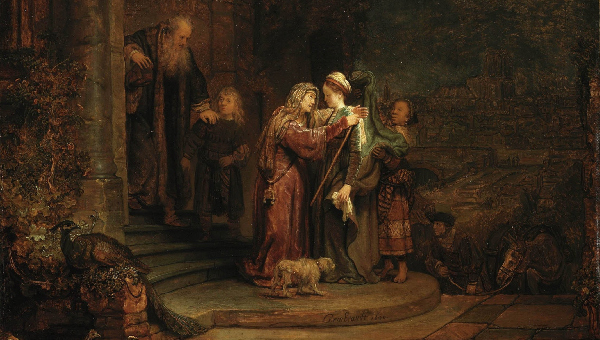Great movies start with a dramatic opening shot. We see the Grand Canyon or the Rocky Mountains. Then we zoom in on the main characters: two cowboys sitting at a campfire at dusk. Superhero movies are similar. We see the New York skyline (why don’t the aliens ever attack Boston or Chicago?); then we get a closeup of Wonder Woman, squinting sternly.
St. Ignatius of Loyola encourages us to approach prayer like a good movie director. We start with the wide angle, and then zoom in on the key figures—reflecting on their faces and hearts. Ignatius outlines several steps to help us contemplate Jesus in the Scriptures (found at the bottom of the article). This method is sometimes called “imaginative prayer” or even Ignatian contemplation.
How to Pray Using Ignatian Contemplation
We can use our imagination to engage Jesus, Mary and the disciples in the Gospels at a deeper, personal level. In contemplation, we first use our five senses to “enter into” the Gospel scene: seeing, hearing, tasting, touching and smelling. Further, we use this method to engage Jesus and the Gospel characters in “spiritual conversation”—speaking and listening “heart to heart” —or, as St. Ignatius simply puts it, “as one friend speaks to another”1.
Let’s look at the Annunciation, where the angel Gabriel speaks to Mary. I write this in the month of October, which is a month especially dedicated to the rosary. Of course, the Annunciation is the first Joyful Mystery. I’ll encourage you to first read the passage: Luke 1:26–38.

Ignatian Contemplation Example
We’ll begin using our sense of sight. Does this scene occur at daytime or at night? St. Luke does not give us this detail. Many artists portray this as a night scene—perhaps Mary was at prayer or awakened from sleep. This likely occurred while Mary was at home, or perhaps in her parents’ home.
Using our physical senses, what would the weather have been like? Nazareth is in Israel, in the Middle East; it is typically sunny and hot in the daytime but cool and breezy at night. What about the smell? A dusty breeze, the scent of approaching rain, or maybe candles burning?
Then, let us focus on the appearance of Mary. She is a young woman, engaged to be married. Look at her face, her eyes as she beholds this angel. Beneath her expression, consider the emotions in her heart. The Gospel tells us that she was “greatly troubled” and “pondered what sort of greeting this might be.”
She asks, “How can this be?”
The angel tells her, “Do not be afraid, Mary.”
We may get a personal sense of Mary feeling overwhelmed, confused, and yet drawn into this grand vocation. She looks up and slowly exhales, now closing her eyes. God has been with her every day. In the synagogue, she’s heard the stories of God’s power and might, leading the Jewish people out of slavery, through the Red Sea and into the Promised Land. She’s heard words from the prophets about a Messiah who will come to save us. She’s chanted the psalms and pondered them at night: “The Lord is my shepherd, there is nothing I shall want.” A tear forms in the corner of her eye, rolling down her cheek.
“And name him Jesus,” says the angel.
“Me?” she prays. “You’re asking me? Then, yes. Fiat. Let it be done to me according to your word.”
Of this moment, St. John simply writes, “And the Word was made flesh and dwelt among us” (Jn 1:14). For the first time, God now takes on human flesh and becomes one of us. In the coming days, the tiny heart of Jesus will begin to beat beneath the heart of Mary as he grows in her womb. God now has a beating human heart. God looks upon the sinful hearts of the human race, seeing our hard hearts. He does not turn away from us. Rather, he offers us his Sacred Heart in his Divine Child, Jesus.
St. Ignatius also encourages me to “reflect on myself.” How do I feel as I read and pray with this passage—joy, hope, fear? Have I ever felt a call from God—and how did I respond? Ignatius then asks us to have a “colloquy,” or friendly conversation with the key characters in a Gospel passage. Is there anything I want to say to Mary? To ask her? Anything she wants to say to me? With her, is there anything I want to say to her Son, Jesus as he takes on human flesh as a tiny child in her womb? Take a moment to reflect on this. You may want to jot down a few words and images in your journal or notebook.

The contemplation continues into Mary’s visitation of her cousin, Elizabeth (Lk 1:39–45). As Mary shares this Good News, Elizabeth’s child, John the Baptist, “leaped for joy in her womb, and Elizabeth, filled with the Holy Spirit, cried out in a loud voice and said, ‘Most blessed are you among women, and blessed is the fruit of your womb.’” This tiny child, the son of Mary and eternal Son of the Father, brings joy. His Good News is spreading—first to Mary, then to Elizabeth and John. And then to Joseph.
Joseph hears two words from Mary that change his life. Mary approaches, touches his hand and looks him in the eye: “I’m pregnant.” She is three months pregnant after visiting Elizabeth; the small bump on her belly confirms her announcement. He looks in her eyes and then looks away. He feels confused and saddened. He may wonder if she has been unfaithful. Perhaps she tries to explain, but it’s hard to put into words: “I was praying, and then I heard…and he me asked if…”
Joseph, “unwilling to expose her to shame, decided to divorce her quietly” (Mt 1:19). His dreams of fatherhood and family life are shattered. He loves Mary and had proposed to her, which she accepted; and now it’s over before it began. He prays that night before going to sleep. A tear forms in the corner of his eye, rolling down his cheek. Physically exhausted, he crawls into bed and falls asleep.
Then an angel appears to him in a dream: “Do not be afraid… For it is through the Holy Spirit that this child has been conceived in her. Name him Jesus.” He awakes. Dazed, he looks around the room. He is alone in the dark night. But he wasn’t alone—and isn’t.

“Do not be afraid.” Easy for angels to say. A light wind blows through the open window. Yellow stars glimmer in the black sky. In the dead of night, Joseph feels quiet and peace. Calm and clear like the sky. Jesus—no one in his family has that name. What would people say? They would surely notice his fiancée’s pregnancy; even his relatives in other cities could do the simple math: “Joseph, when were you married? And the boy was born in late December, wasn’t he?” “Name him Jesus.” Well, who cares what they think?
Joseph “did as the angel of the Lord had commanded him and took his wife into his home” (Mt 1:24). He finds Mary, looks her in the eye and touches her hand. “Mary, I love you and want you as my wife. There’s just one thing. I know what we should name the child.” She smiles and says, “Jesus.”
Mary and Joseph are models of faith and prayer for us. Our Catholic faith teaches that in prayer, we can talk with the saints and they can talk with us. Ignatian contemplation helps us to see them, hear them, know them, and walk with them. The saints are living, breathing people. They are not statues. They experience emotions, joys, sorrows, and blessings just like us. Reflecting on a Gospel passage using this method of prayer, I may notice new details or experience new graces.

If a friend and I each pray about a particular Gospel passage, the graces we receive will be personal and distinct—for the Lord knows our hearts and what we need. There is a wonderful ‘unity and diversity’ in this mode of prayer; the one Light of Christ shines uniquely in every human heart.
A final note: Many people find this to be a powerful mode of prayer. Others get a bit nervous: “So, I’m just supposed to use my imagination? How do I know if I’m doing it right?” Certainly, if we notice that our prayer is drifting out of Church teaching, then we need to recenter. If I imagine St. Peter telling me that my sins can’t be forgiven, then I know I’m off track. Just go back to the text. What is happening? Who is there? What is Jesus saying? This kind of prayer does require patience and trust. Sometimes little children are better at it than adults!2
Fr. Joe Laramie, SJ is the new North American director of the Pope’s Worldwide Prayer Network (Apostleship of Prayer), based in Milwaukee. He is the author of Abide in the Heart of Christ: a 10-Day Personal Retreat with St. Ignatius Loyola, based on the Spiritual Exercises.
PopesPrayerUSA.net JoeLaramieSJ.com
@PopesPrayerUSA @JoeLaramieSJ
Easy Steps for How to Pray Ignatian Contemplation, According to St. Ignatius
- First, Review the History (read the Gospel passage).
- The Composition (visual imagination, “wide shot”). “By imagining the place—for example, see the road from Nazareth to Jerusalem. Its length and breadth, level or winding through valleys & hills.”
- Interior Knowledge (pray from the heart). “Ask for an interior knowledge of Our Lord, who became man for me, that I may know him more, love him more, follow him more.”
- See the Persons (imagination, zoom in for a close-up). “To see Our Lady, Joseph.”
- Five Senses (seeing, hearing, smelling, tasting, touching). Places, people, faces, emotions.
- Participate (“place myself in the scene”). “I will make myself a poor, little, and unworthy servant, gazing at them, contemplating them and serving them in their needs, just as if I were there.”
- Heart Check (my heart). “Then I will reflect on myself to draw some profit.”
- Listen (to dialogue). “Observe what they are saying.”
- See the Action (their actions and their meaning). “Consider what they are doing: journeying and toiling in order that the Lord may be born in the greatest poverty.”
- Heart to Heart (listen, speak). Conclude with a conversation with Jesus or Mary, “as a friend speaks to a friend, or a servant to a leader; telling my concerns, asking for advice.”
- Close with a Familiar Prayer. Our Father, Hail Mary, etc.
